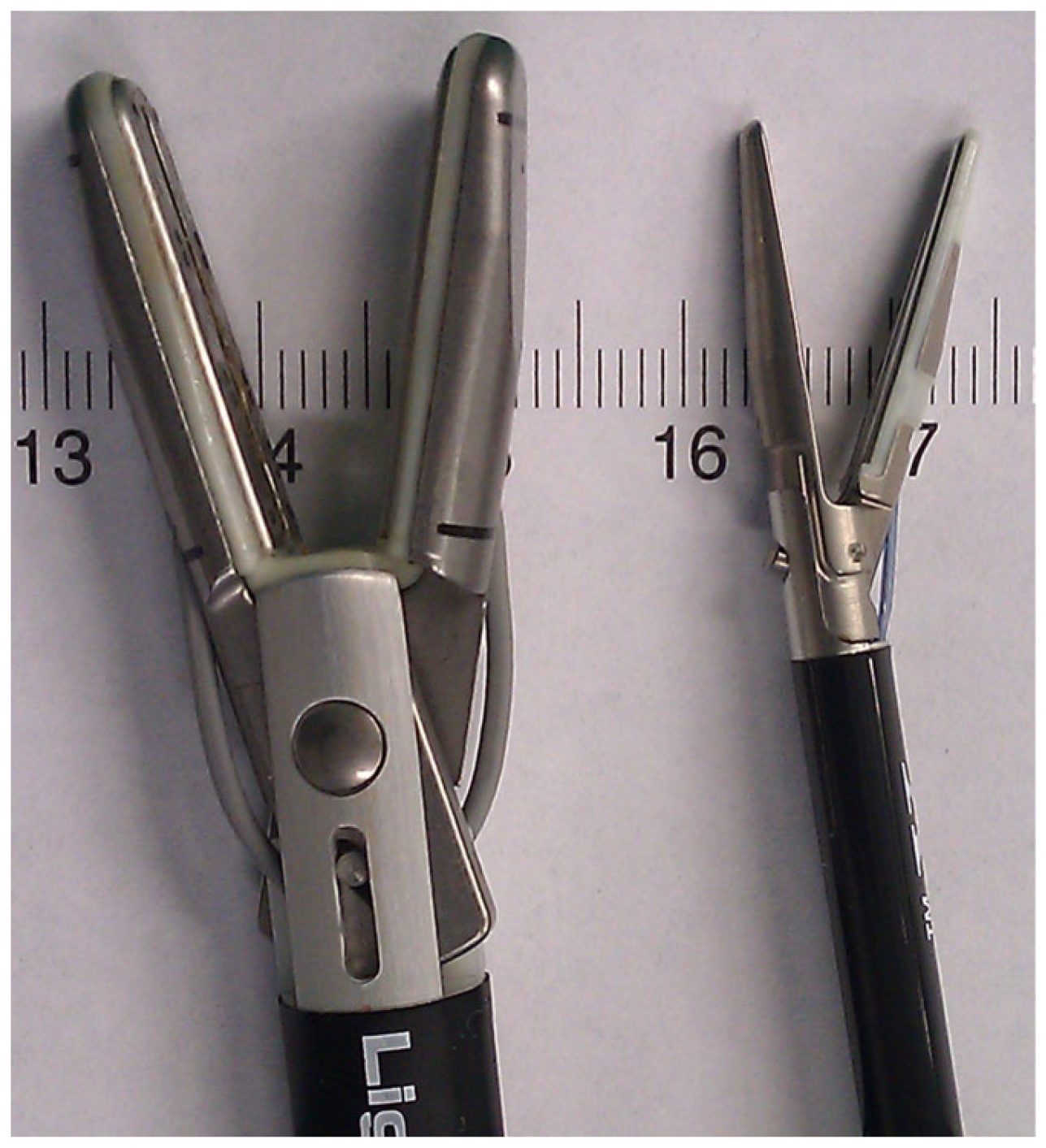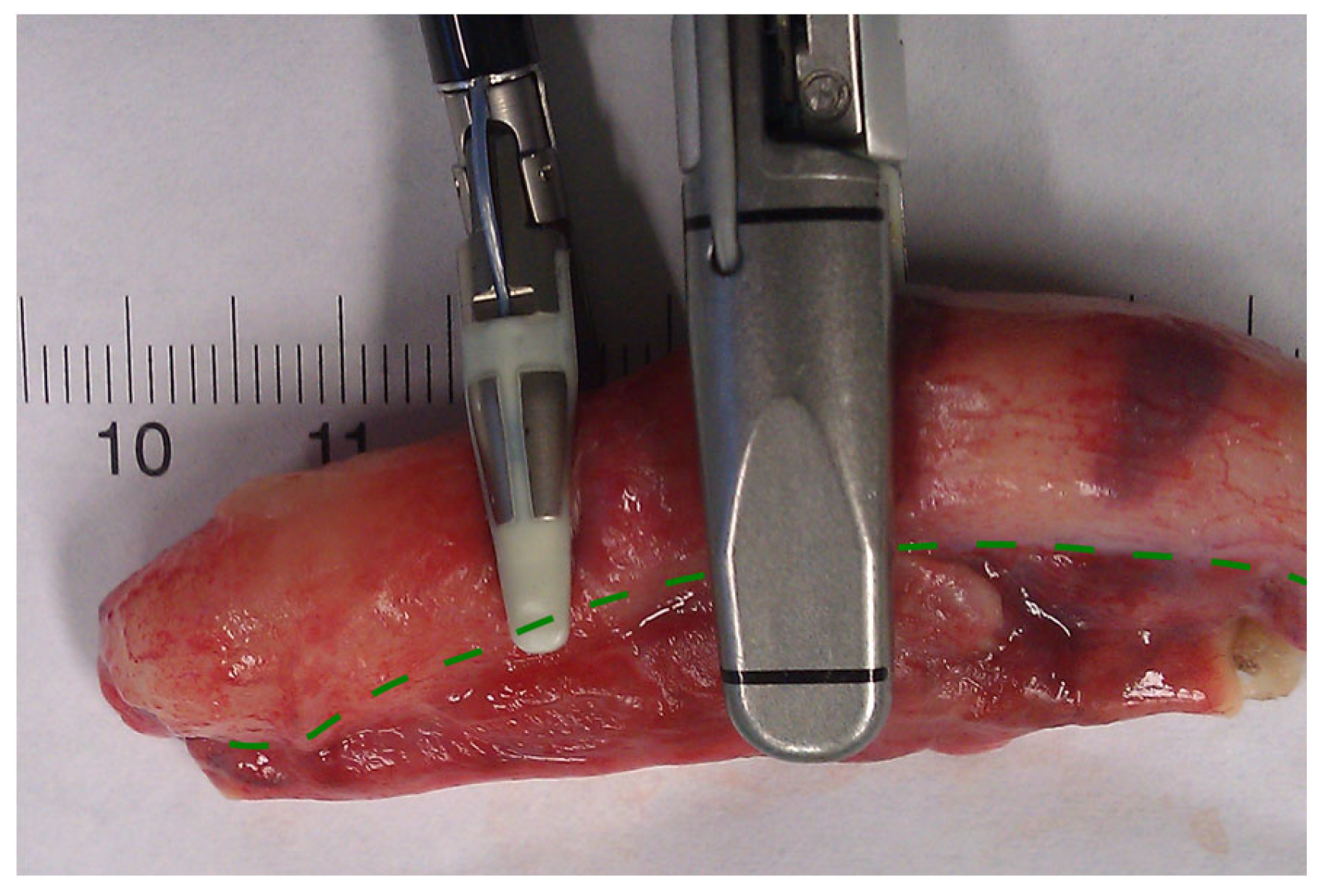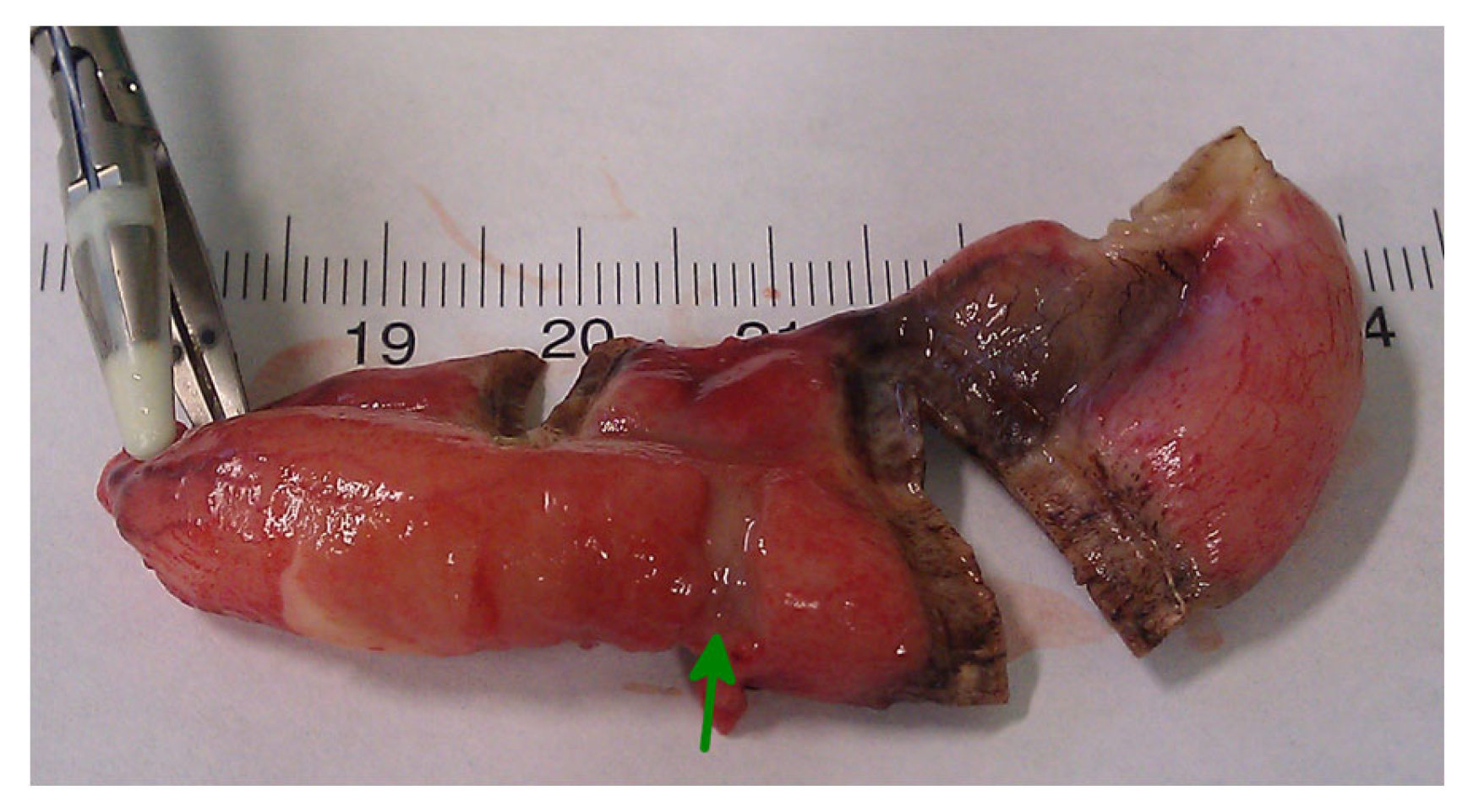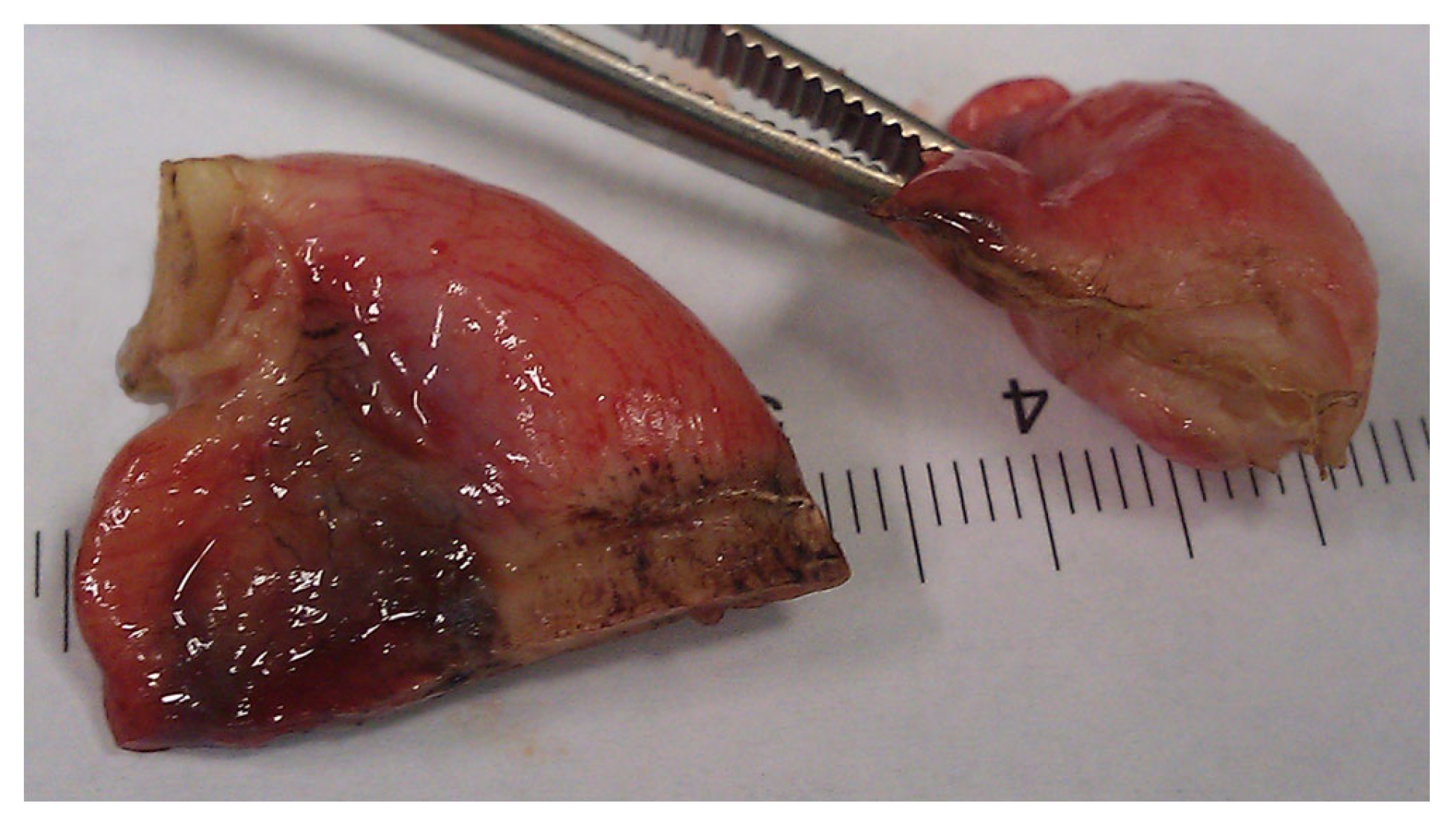Evaluation of the Appropriate LigaSure™ Device to Transect the Appendix—A Comparison between 5 mm and 10 mm Laparoscopic Devices in an Ex Vivo Trial
Abstract
:1. Introduction
2. Materials and Methods
3. Results
4. Discussion
5. Conclusions
Author Contributions
Funding
Institutional Review Board Statement
Informed Consent Statement
Data Availability Statement
Conflicts of Interest
References
- Rentea, R.M.; Peter, S.D.S.; Snyder, C.L. Pediatric appendicitis: State of the art review. Pediatr. Surg. Int. 2017, 33, 269–283. [Google Scholar] [CrossRef] [PubMed]
- Schier, F. Laparoscopic appendectomy with 1.7-mm instruments. Pediatr. Surg. Int. 1998, 14, 142–143. [Google Scholar] [CrossRef] [PubMed]
- Flores, J.V.; Avila, A.L.V.; Cruz, I.D.A.; Jimenez, S.D.L.; Pacheco, J.S.; Ancona, J.F.N.; Valdes, J.V.; Roman, E.B. Zaragoza technique of laparoscopic appendicectomy. Ann. Med. Surg. 2021, 65, 102331. [Google Scholar] [CrossRef] [PubMed]
- Yu, M.C.; Feng, Y.J.; Wang, W.; Fan, W.; Cheng, H.T.; Xu, J. Is laparoscopic appendectomy feasible for complicated appendicitis? A systematic review and meta-analysis. Int. J. Surg. 2017, 40, 187–197. [Google Scholar] [CrossRef]
- Quah, G.S.; Eslick, G.D.; Cox, M.R. Laparoscopic appendicectomy is superior to open surgery for complicated appendicitis. Surg. Endosc. 2019, 33, 2072–2082. [Google Scholar] [CrossRef]
- Del Pino, C.; Muñoz, R.; Rada, G. Laparoscopic versus open appendectomy for complicated appendicitis. Medwave 2018, 18, e7370. [Google Scholar] [CrossRef]
- Talha, A.; El-Haddad, H.; Ghazal, A.E.; Shehata, G. Laparoscopic versus open appendectomy for perforated appendicitis in adults: Randomized clinical trial. Surg. Endosc. 2020, 34, 907–914. [Google Scholar] [CrossRef]
- Jaschinski, T.; Mosch, C.G.; Eikermann, M.; Neugebauer, E.A.; Sauerland, S. Laparoscopic versus open surgery for suspected appendicitis. Cochrane Database Syst. Rev. 2018, 11, CD001546. [Google Scholar] [CrossRef]
- Mannu, G.S.; Sudul, M.K.; Bettencourt-Silva, J.H.; Cumber, E.; Li, F.; Clark, A.B.; Loke, Y.K. Closure methods of the appendix stump for complications during laparoscopic appendectomy. Cochrane Database Syst. Rev. 2017, 11, CD006437. [Google Scholar] [CrossRef]
- Makaram, N.; Knight, S.R.; Ibrahim, A.; Patil, P.; Wilson, M.S.J. Closure of the appendiceal stump in laparoscopic appendectomy: A systematic review of the literature. Ann. Med. Surg 2020, 57, 228–235. [Google Scholar] [CrossRef]
- Lasek, A.; Wysocki, M.; Mavrikis, J.; Myśliwiec, P.; Bobowicz, M.; Dowgiałło-Wnukiewicz, N.; Kenig, J.; Stefura, T.; Walędziak, M.; Pędziwiatr, M.; et al. Comparison of stump closure techniques during laparoscopic appendectomies for complicated appendicitis: Results from Pol-LA (Polish laparoscopic appendectomy) multicenter large cohort study. Acta Chir. Belg. 2020, 120, 116–123. [Google Scholar] [CrossRef] [PubMed]
- Slakey, D.P. Laparoscopic liver resection using a bipolar vessel-sealing device: LigaSure. HPB 2008, 10, 253–255. [Google Scholar] [CrossRef] [PubMed]
- Meurisse, M.; Defechereux, T.; Maweja, S.; Degauque, C.; Vandelaer, M.; Hamoir, E. Evaluation of the ultracision dissector in thyroid surgery: Prospective randomized study. Ann. Chir. 2000, 125, 468–472. [Google Scholar] [CrossRef] [PubMed]
- Medtronic. Vessel-Sealing. Available online: https://www.medtronic.com/covidien/en-us/products/vessel-sealing.html (accessed on 21 September 2022).
- Prinicpals in Electrosurgery. Available online: https://www.asit.org/assets/documents/Prinicpals_in_electrosurgery.pdf (accessed on 21 September 2022).
- Smith, R.B.; Coughlin, A. Thyroidectomy Hemostasis. Otolaryngol. Clin. N. Am. 2016, 49, 727–748. [Google Scholar] [CrossRef]
- Takiguchi, N.; Nagata, M.; Soda, H.; Nomura, Y.; Takayama, W.; Yasutomi, J.; Tohyama, Y.; Ryu, M. Multicenter randomized comparison of LigaSure versus conventional surgery for gastrointestinal carcinoma. Surg. Today 2010, 40, 1050–1054. [Google Scholar] [CrossRef] [PubMed]
- Yao, H.S.; Wang, Q.; Wang, W.J.; Ruan, C.P. Prospective clinical trials of thyroidectomy with LigaSure vs conventional vessel ligation: A systematic review and meta-analysis. Arch. Surg. 2009, 144, 1167–1174. [Google Scholar] [CrossRef]
- Zaidi, N.; Glover, A.R.; Sidhu, S.B. The Covidien LigaSure Maryland Jaw Device. Expert Rev. Med. Devices 2015, 12, 151–155. [Google Scholar] [CrossRef]
- Karande, V.C. LigaSure™ 5-mm Blunt Tip Laparoscopic Instrument. J. Obstet. Gynaecol. India 2015, 65, 350–352. [Google Scholar] [CrossRef]
- Pons, Y.; Gauthier, J.; Ukkola-Pons, E.; Clément, P.; Roguet, E.; Poncet, J.L.; Conessa, C. Comparison of LigaSure vessel sealing system, harmonic scalpel, and conventional hemostasis in total thyroidectomy. Otolaryngol. Head Neck Surg. 2009, 141, 496–501. [Google Scholar] [CrossRef]
- Ng, D.Y.L.; Petrushnko, W.; Kelly, M.D. Clip as Nidus for Choledocholithiasis after Cholecystectomy-Literature Review. JSLS J. Soc. Laparosc. Robot. Surg. 2020, 24, e2019.00053. [Google Scholar] [CrossRef]
- Qian, N.S.; Liao, Y.H.; Cai, S.W.; Raut, V.; Dong, J.H. Comprehensive application of modern technologies in precise liver resec-tion. Hepatobiliary Pancreat. Dis. Int. 2013, 12, 244–250. [Google Scholar] [CrossRef] [PubMed]
- Erdem, M.R.; Tepeler, A.; Gunes, M.; Sılay, M.S.; Akman, T.; Akcay, M.; Armagan, A.; Onol, S.Y. Laparoscopic decortication of hilar renal cysts using LigaSure. JSLS 2014, 18, 301–307. [Google Scholar] [CrossRef] [PubMed]
- Wei, M.T.; Yang, T.H.; Deng, X.B.; Meng, W.J.; Han, J.H.; Zhou, Z.G.; Wang, Z.Q. Laparoscopic colorectal anastomosis technique without “dog ear” formation using LigaSure for bowel transection. Tech. Coloproctol. 2020, 24, 207–210. [Google Scholar] [CrossRef] [PubMed]
- Nouri, K.; Ott, J.; Demmel, M.; Promberger, R.; Huber, J.C.; Mayerhofer, K. Bipolar vessel sealing increases operative safety in laparoscopic-assisted vaginal hysterectomy. Arch. Gynecol. Obstet. 2011, 283, 91–95. [Google Scholar] [CrossRef]
- Lambert, E.H.; Schachter, L.R.; Altamar, H.O.; Tikhonenkov, S.; Moeckel, G.; Miller, N.L.; Herrell, S.D. A sealed bladder cuff tech-nique during laparoscopic nephroureterectomy utilizing the LigaSure electrosurgical device: Laboratory and clinical experience. J. Endourol. 2010, 24, 327–332. [Google Scholar] [CrossRef]
- Hartwig, W.; Duckheim, M.; Strobel, O.; Dovzhanskiy, D.; Bergmann, F.; Hackert, T.; Büchler, M.W.; Werner, J. LigaSure for pan-creatic sealing during distal pancreatectomy. World J. Surg. 2010, 34, 1066–1070. [Google Scholar] [CrossRef]
- Kovács, O.; Szántó, Z.; Krasznai, G.; Herr, G. Comparing bipolar electrothermal device and endostapler in endoscopic lung wedge resection. Interact. Cardiovasc. Thorac. Surg. 2009, 9, 11–14. [Google Scholar] [CrossRef]
- Cakan, A.; Yoldas, B.; Samancilar, O.; Ertugrul, V.; Turhan, K.; Cagirici, U.; Askar, F.; Veral, A. Ligasure vessel sealing system versus harmonic scalpel for suturelessnonanatomical pulmonary resections in a rabbit model. Which one is safer? Eur. Surg. Res. 2009, 43, 24–28. [Google Scholar] [CrossRef]
- Nii, A.; Shimada, M.; Ikegami, T.; Mori, H.; Imura, S.; Arakawa, Y.; Morine, Y.; Kanemura, H. Efficacy of vessel sealing system for major Glisson bundles and major bile ducts. J. Hepatobiliary Pancreat. Surg. 2008, 15, 522–527. [Google Scholar] [CrossRef]
- Gehrig, T.; Fonouni, H.; Müller-Stich, B.P.; Golriz, M.; Abbassi, S.; Nickel, F.; Esmaeilzadeh, M.; Brand, K.; Rad, M.T.; Hughes, K.M.; et al. Comparison of different surgical techniques in distal pancreatectomy: An experimental study in a porcine model. Surg. Innov. 2011, 18, 329–337. [Google Scholar] [CrossRef]
- Gehrig, T.; Müller-Stich, B.P.; Kenngott, H.; Fischer, L.; Mehrabi, A.; Büchler, M.W.; Gutt, C.N. LigaSure versus conventional dis-section technique in pancreatoduodenectomy: A pilot study. Am. J. Surg. 2011, 201, 166–170. [Google Scholar] [CrossRef] [PubMed]
- Turial, S.; Engel, V.; Sultan, T.; Schier, F. Closure of the cystic duct during laparoscopic cholecystectomy in children using the LigaSure Vessel Sealing System. World J. Surg. 2011, 35, 212–216. [Google Scholar] [CrossRef] [PubMed]
- Aydogan, F.; Saribeyoglu, K.; Simsek, O.; Salihoglu, Z.; Carkman, S.; Salihoglu, T.; Karatas, A.; Baca, B.; Kucuk, O.; Yavuz, N.; et al. Comparison of the electrothermal vessel-sealing system versus endoclip in laparoscopic appendectomy. J. Laparoendosc. Adv. Surg. Tech. A 2009, 19, 375–378. [Google Scholar] [CrossRef] [PubMed]
- Sucullu, I.; Filiz, A.I.; Kurt, Y.; Yilmaz, I.; Yildiz, M. The effects of LigaSure on the laparoscopic management of acute appendi-citis: "LigaSure assisted laparoscopic appendectomy". Surg. Laparosc. Endosc. Percutan. Tech. 2009, 19, 333–335. [Google Scholar] [CrossRef] [PubMed]
- Elemen, L.; Yazir, Y.; Tugay, M.; Akay, A.; Aydin, S.; Yanar, K.; Ceylan, S. LigaSure compared with ligatures and endoclips in experimental appendectomy: How safe is it? Pediatr. Surg. Int. 2010, 26, 539–545. [Google Scholar] [CrossRef]
- Gupta, V.; Chauhan, S.P.S.; Gupta, M.; Verma, R.; Singh, S.P.; Panday, A. Efficacy and Safety of LigaSure in Laparoscopic Suture-Less Appendectomy. Cureus 2022, 14, e24764. [Google Scholar] [CrossRef]
- Searle, A.R.; Ismail, K.A.; Macgregor, D.; Hutson, J.M. Changes in the length and diameter of the normal appendix throughout childhood. J. Pediatr. Surg. 2013, 48, 1535–1539. [Google Scholar] [CrossRef]
- Trout, A.T.; Towbin, A.J.; Fierke, S.R.; Zhang, B.; Larson, D.B. Appendiceal diameter as a predictor of appendicitis in children: Improved diagnosis with three diagnostic categories derived from a logistic predictive model. Eur. Radiol. 2015, 25, 2231–2238. [Google Scholar] [CrossRef]
- Matthews, B.D.; Pratt, B.L.; Backus, C.L.; Kercher, K.W.; Mostafa, G.; Lentzner, A.; Lipford, E.H.; Sing, R.F.; Heniford, B.T. Effectiveness of the ultrasonic coagulating shears, LigaSure vessel sealer, and surgical clip application in biliary surgery: A compara-tive analysis. Am. Surg. 2001, 67, 901–906. [Google Scholar] [CrossRef]
- Kandil, T.; El Nakeeb, A.; El Hefnawy, E. Comparative study between clipless laparoscopic cholecystectomy by harmonic scalpel versus conventional method: A prospective randomized study. J. Gastrointest. Surg. 2010, 14, 323–328. [Google Scholar] [CrossRef]
- Ponsky, T.A.; Rothenberg, S.S. Division of the mesoappendix with electrocautery in children is safe, effective, and cost-efficient. J. Laparoendosc. Adv. Surg. Tech. A 2009, 19 (Suppl. S1), S11–S13. [Google Scholar] [CrossRef] [PubMed]
- Uno, Y. Colonic transit time and pressure based on Bernoulli’s principle. Clin. Exp. Gastroenterol. 2018, 11, 153–163. [Google Scholar] [CrossRef] [PubMed]
- Hasler, W.L.; Saad, R.J.; Rao, S.S.; Wilding, G.E.; Parkman, H.P.; Koch, K.L.; McCallum, R.W.; Kuo, B.; Sarosiek, I.; Sitrin, M.D.; et al. Heightened colon motor activity measured by a wireless capsule in patients with constipation: Relation to colon transit and IBS. Am. J. Physiol. Gastrointest. Liver Physiol. 2009, 297, G1107–G1114. [Google Scholar] [CrossRef] [PubMed]
- Saad, R.J.; Hasler, W.L. A technical review and clinical assessment of the wireless motility capsule. Gastroenterol. Hepatol. 2011, 7, 795–804. [Google Scholar]
- Tran, K.; Brun, R.; Kuo, B. Evaluation of regional and whole gut motility using the wireless motility capsule: Relevance in clinical practice. Therap. Adv. Gastroenterol. 2012, 5, 249–260. [Google Scholar] [CrossRef]
- Sequeira, I.R.; Lentle, R.G.; Kruger, M.C.; Hurst, R.D. Assessment of the Effect of Intestinal Permeability Probes (Lactulose And Mannitol) and Other Liquids on Digesta Residence Times in Various Segments of the Gut Determined by Wireless Mo-Tility Capsule: A Randomised Controlled Trial. PLoS ONE 2015, 10, e0143690. [Google Scholar] [CrossRef]






| Statistics Test a | ||
|---|---|---|
| Exact sig. (2-tailed) | Exact sig. (1-tailed) | |
| Number of grasps with the 10 mm instrument vs. grasps with the 5 mm instrument | 0.002 b | <0.001 |
| BP with the 10 mm instrument vs. BP with the 5 mm instrument | 0.004 b | 0.002 |
| Adequacy with the 10 mm instrument vs. Adequacy with the 5 mm instrument | 0.008 b | 0.004 |
| Leakage with the 10 mm instrument vs. Leakage with the 5 mm instrument | 0.031 b | 0.016 |
| Histopathological finding of the sealed area (HPFSA) with the 10 mm instrument vs. Histopathological finding of the sealed area with the 5 mm instrument | 0.008 b | 0.004 |
| N | |||
|---|---|---|---|
| Grasps 10 mm instrument vs. Grasps 5 mm instrument | Negative Differences | 10 | Grasps 10 mm < Grasps 5 mm |
| Positive Differences | 0 | Grasps 10 mm > Grasps 5 mm | |
| Ties | 0 | Grasps 10 mm = Grasps 5 mm | |
| Total | 10 | ||
| BP 10 mm instrument vs. BP 5 mm instrument | Negative Differences | 0 | BP 10 mm < BP 5 mm |
| Positive Differences | 9 | BP 10 mm > BP 5 mm | |
| Ties | 1 | B Press 10 mm = B Press 5 mm | |
| Total | 10 | ||
| Adequacy 10 mm instrument vs. Adequacy 5 mm instrument | Negative Differences | 8 | Adequacy 10 mm < Adequacy 5 mm |
| Positive Differences | 0 | Adequacy 10 mm > Adequacy 5 mm | |
| Ties | 2 | Adequacy 10 mm = Adequacy 5 mm | |
| Total | 10 | ||
| Leakage 10 mm instrument vs. Leakage 5 mm instrument | Negative Differences | 6 | Leakage 10 mm < Leakage 5 mm |
| Positive Differences | 0 | Leakage 10 mm > Leakage 5 mm | |
| Ties | 4 | Leakage 10 mm = Leakage 5 mm | |
| Total | 10 | ||
| HPFSA 10 mm–HPFSA 5 mm | Negative Differences | 8 | HPFSA 10 mm < HPFSA 5 mm |
| Positive Differences | 0 | HPFSA 10 mm > HPFSA 5 mm | |
| Ties | 2 | HPFSA 10 mm = HPFSA 5 mm | |
| Total | 10 |
Disclaimer/Publisher’s Note: The statements, opinions and data contained in all publications are solely those of the individual author(s) and contributor(s) and not of MDPI and/or the editor(s). MDPI and/or the editor(s) disclaim responsibility for any injury to people or property resulting from any ideas, methods, instructions or products referred to in the content. |
© 2023 by the authors. Licensee MDPI, Basel, Switzerland. This article is an open access article distributed under the terms and conditions of the Creative Commons Attribution (CC BY) license (https://creativecommons.org/licenses/by/4.0/).
Share and Cite
Turial, S.; Schwind, M.; Nyiredi, A. Evaluation of the Appropriate LigaSure™ Device to Transect the Appendix—A Comparison between 5 mm and 10 mm Laparoscopic Devices in an Ex Vivo Trial. Medicina 2023, 59, 927. https://doi.org/10.3390/medicina59050927
Turial S, Schwind M, Nyiredi A. Evaluation of the Appropriate LigaSure™ Device to Transect the Appendix—A Comparison between 5 mm and 10 mm Laparoscopic Devices in an Ex Vivo Trial. Medicina. 2023; 59(5):927. https://doi.org/10.3390/medicina59050927
Chicago/Turabian StyleTurial, Salmai, Martin Schwind, and Alexandra Nyiredi. 2023. "Evaluation of the Appropriate LigaSure™ Device to Transect the Appendix—A Comparison between 5 mm and 10 mm Laparoscopic Devices in an Ex Vivo Trial" Medicina 59, no. 5: 927. https://doi.org/10.3390/medicina59050927





